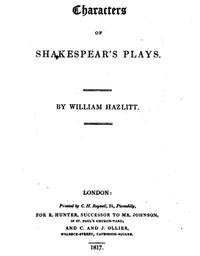#CharactersOfShakespearsPlays
Characters of Shakespear's Plays
Characters of Shakespear's Plays is an 1817 book of criticism of Shakespeare's plays, written by early nineteenth century English essayist and literary critic William Hazlitt. Composed in reaction to the neoclassical approach to Shakespeare's plays
Read More..
by William Hazlitt
Ratings
Likes
Reviews
Popularity
Ranks
This #hashtag is not ranked yet.


